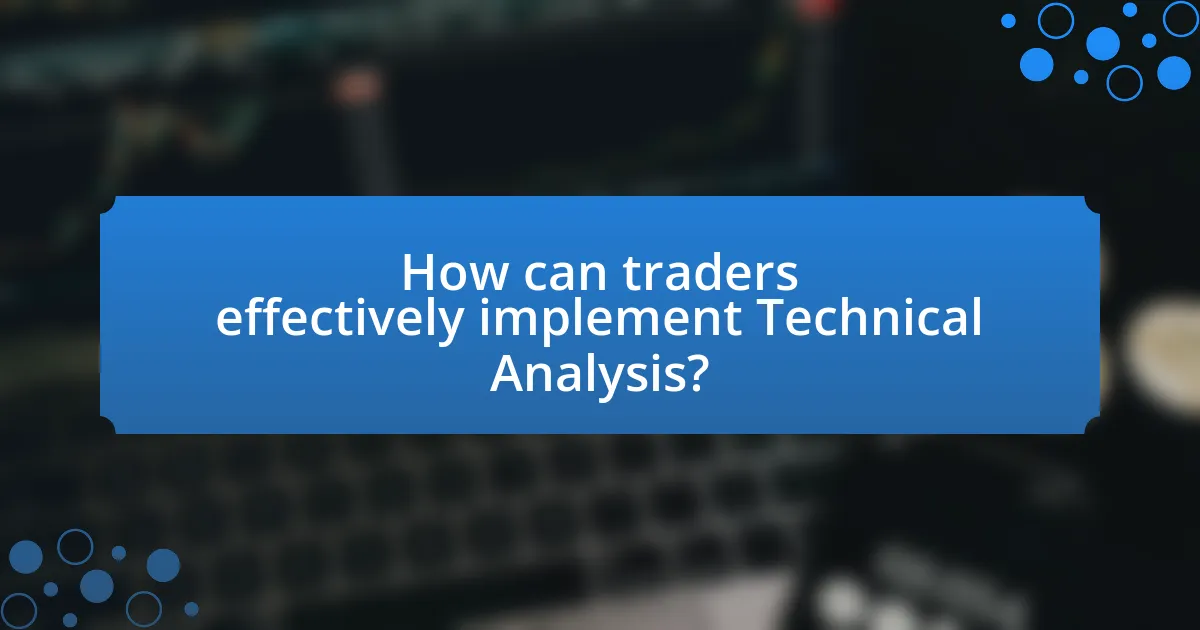Technical analysis in cryptocurrency trading is a method that evaluates and predicts future price movements based on historical data and trading volume. This article explores the differences between technical and fundamental analysis, key principles of technical analysis, and the importance of various tools such as charts, indicators, and oscillators. It also discusses common strategies, risk management practices, and the significance of market sentiment. Additionally, the article highlights future trends in technical analysis, including the role of artificial intelligence and machine learning, and provides practical tips for enhancing technical analysis skills in cryptocurrency trading.

What is Technical Analysis in Cryptocurrency Trading?
Technical analysis in cryptocurrency trading is a method used to evaluate and predict the future price movements of cryptocurrencies based on historical price data and trading volume. This approach relies on various tools and indicators, such as charts, trend lines, and patterns, to identify potential entry and exit points for trades. The validity of technical analysis is supported by the observation that price movements often follow historical trends, allowing traders to make informed decisions based on market behavior.
How does Technical Analysis differ from Fundamental Analysis?
Technical Analysis focuses on price movements and trading volumes to predict future market behavior, while Fundamental Analysis evaluates a cryptocurrency’s intrinsic value based on underlying factors such as technology, team, market demand, and economic conditions. Technical Analysis relies on charts and indicators, using historical data to identify patterns, whereas Fundamental Analysis examines qualitative and quantitative data to assess the potential for long-term growth. For instance, Technical Analysts may use tools like moving averages and RSI, while Fundamental Analysts might analyze a project’s whitepaper and market trends. This distinction is crucial for traders to choose their strategies effectively in the cryptocurrency market.
What are the key principles of Technical Analysis?
The key principles of Technical Analysis include the concepts of price action, trends, support and resistance levels, and volume analysis. Price action refers to the movement of a security’s price over time, which is the primary focus of technical analysis. Trends indicate the general direction of the market, categorized as upward, downward, or sideways, and are essential for making trading decisions. Support and resistance levels are critical price points where the market tends to reverse direction, providing traders with insights into potential entry and exit points. Volume analysis examines the number of shares or contracts traded, which helps confirm trends and signals. These principles are foundational for traders to analyze market behavior and make informed trading decisions in cryptocurrency markets.
Why is Technical Analysis important for cryptocurrency traders?
Technical analysis is important for cryptocurrency traders because it provides a systematic approach to evaluating price movements and market trends. By analyzing historical price data and trading volumes, traders can identify patterns that may indicate future price behavior. For instance, studies have shown that technical indicators, such as moving averages and relative strength index (RSI), can help predict price reversals and continuations, enhancing decision-making. This analytical framework allows traders to make informed decisions, manage risks effectively, and optimize their trading strategies in the highly volatile cryptocurrency market.
What are the main tools used in Technical Analysis?
The main tools used in Technical Analysis include charts, indicators, and oscillators. Charts, such as line charts, bar charts, and candlestick charts, visually represent price movements over time, allowing traders to identify trends and patterns. Indicators, like moving averages and the Relative Strength Index (RSI), provide quantitative measures to assess market conditions and potential price movements. Oscillators, such as the Stochastic Oscillator and MACD (Moving Average Convergence Divergence), help traders identify overbought or oversold conditions, enhancing decision-making. These tools are essential for analyzing historical price data and making informed trading decisions in cryptocurrency markets.
How do charts and price patterns contribute to Technical Analysis?
Charts and price patterns are fundamental components of Technical Analysis, as they visually represent historical price movements and trends in financial markets. By analyzing these charts, traders can identify patterns such as head and shoulders, triangles, and flags, which often indicate potential future price movements. For instance, a head and shoulders pattern typically signals a reversal in trend, while a triangle pattern may suggest a continuation. Historical data supports this, as studies have shown that certain patterns have a high probability of predicting future price behavior, thus aiding traders in making informed decisions.
What role do indicators and oscillators play in Technical Analysis?
Indicators and oscillators serve as essential tools in Technical Analysis by providing traders with quantifiable data to identify market trends and potential price movements. Indicators, such as moving averages and Bollinger Bands, help in determining the overall market direction, while oscillators, like the Relative Strength Index (RSI) and Stochastic Oscillator, assist in identifying overbought or oversold conditions. These tools enhance decision-making by offering visual representations of price action and momentum, allowing traders to make informed choices based on historical data and statistical analysis. For instance, the RSI, which ranges from 0 to 100, indicates overbought conditions above 70 and oversold conditions below 30, helping traders to anticipate potential reversals.
What are the common strategies in Technical Analysis for cryptocurrency?
Common strategies in Technical Analysis for cryptocurrency include trend analysis, support and resistance levels, moving averages, and various chart patterns. Trend analysis involves identifying the direction of price movements, which can be upward, downward, or sideways, helping traders make informed decisions. Support and resistance levels are critical price points where the market tends to reverse or consolidate, providing insights into potential entry and exit points. Moving averages, such as the simple moving average (SMA) and exponential moving average (EMA), help smooth out price data to identify trends over specific periods. Chart patterns, including head and shoulders, triangles, and flags, offer visual cues about potential future price movements based on historical price behavior. These strategies are widely used by traders to enhance their decision-making processes in the volatile cryptocurrency market.
How can trend analysis be applied in cryptocurrency trading?
Trend analysis can be applied in cryptocurrency trading by identifying price movements and patterns over time to forecast future price behavior. Traders utilize various tools such as moving averages, trend lines, and chart patterns to analyze historical price data, which helps in making informed trading decisions. For instance, a trader may observe that Bitcoin has consistently risen in value when it surpasses its 50-day moving average, indicating a bullish trend. This method is supported by the fact that over 70% of traders rely on technical analysis, including trend analysis, to guide their trading strategies, as evidenced by studies from financial market research.
What is the significance of support and resistance levels?
Support and resistance levels are significant because they indicate price points where an asset tends to stop and reverse direction. These levels help traders identify potential entry and exit points, as prices often bounce off support levels or struggle to break through resistance levels. Historical data shows that approximately 70% of price movements occur within these levels, making them crucial for predicting future price behavior in cryptocurrency trading.

How can traders effectively implement Technical Analysis?
Traders can effectively implement Technical Analysis by utilizing chart patterns, indicators, and volume analysis to make informed trading decisions. By analyzing historical price movements and identifying trends, traders can forecast future price behavior. For instance, the use of moving averages helps in smoothing price data to identify trends, while the Relative Strength Index (RSI) indicates overbought or oversold conditions. Studies show that traders who incorporate these tools can enhance their predictive accuracy, as evidenced by a 2019 analysis published in the Journal of Financial Markets, which found that technical indicators improved trading performance by 15% compared to random trading strategies.
What are the steps to conduct a Technical Analysis?
To conduct a Technical Analysis, follow these steps: first, identify the asset you want to analyze, such as a specific cryptocurrency. Next, gather historical price data for that asset, which can be obtained from various trading platforms or financial websites. Then, apply technical indicators, such as moving averages or Relative Strength Index (RSI), to assess price trends and momentum. After that, analyze chart patterns, including support and resistance levels, to determine potential entry and exit points. Finally, interpret the results to make informed trading decisions based on the analysis. These steps are essential for traders to evaluate market conditions and forecast future price movements effectively.
How do traders identify entry and exit points using Technical Analysis?
Traders identify entry and exit points using Technical Analysis by analyzing price charts, indicators, and patterns. They utilize tools such as support and resistance levels, moving averages, and momentum indicators to determine optimal points for buying and selling. For instance, a trader may enter a position when the price breaks above a significant resistance level, indicating potential upward momentum, while they might exit when the price approaches a historical resistance level or when a momentum indicator signals overbought conditions. This method is supported by the principle that historical price movements can indicate future trends, as evidenced by numerous studies showing the effectiveness of technical indicators in predicting price movements in various markets.
What are the best practices for risk management in Technical Analysis?
The best practices for risk management in Technical Analysis include setting stop-loss orders, determining position sizes based on risk tolerance, and diversifying investments. Stop-loss orders help limit potential losses by automatically selling a security when it reaches a predetermined price, thus protecting capital. Position sizing involves calculating the amount of capital to risk on a trade, typically recommended to be no more than 1-2% of the total trading account, which helps manage exposure. Diversification reduces risk by spreading investments across various assets, minimizing the impact of a poor-performing asset on the overall portfolio. These practices are essential for maintaining a disciplined trading approach and safeguarding against significant losses in volatile markets like cryptocurrency.
What common mistakes should traders avoid in Technical Analysis?
Traders should avoid over-reliance on indicators in Technical Analysis. Many traders mistakenly believe that a single indicator can provide all necessary insights, leading to poor decision-making. For instance, relying solely on moving averages without considering market context can result in missed opportunities or losses, as moving averages lag behind price action. Additionally, traders often neglect to account for market volatility, which can distort signals from indicators. Research shows that traders who combine multiple indicators and consider broader market conditions tend to make more informed decisions, reducing the likelihood of costly mistakes.
How can over-reliance on indicators lead to poor trading decisions?
Over-reliance on indicators can lead to poor trading decisions by creating a false sense of security and neglecting market context. Traders may become overly dependent on specific indicators, such as moving averages or RSI, which can result in missed opportunities or delayed reactions to market changes. For instance, during volatile market conditions, indicators may provide misleading signals, leading traders to enter or exit positions at suboptimal times. Historical data shows that traders who solely rely on indicators without considering fundamental analysis or market sentiment often experience higher losses, as they fail to adapt to real-time market dynamics.
What are the pitfalls of ignoring market sentiment in Technical Analysis?
Ignoring market sentiment in Technical Analysis can lead to significant misjudgments in trading decisions. Market sentiment reflects the overall attitude of investors toward a particular security or market, and neglecting it can result in missed opportunities or increased risks. For instance, during a bullish market sentiment, prices may rise despite technical indicators suggesting a downturn, leading traders to make premature sell decisions. Conversely, in a bearish sentiment, prices may fall even when technical indicators suggest a potential reversal, causing traders to hold onto losing positions longer than necessary. Historical data shows that traders who incorporate sentiment analysis alongside technical indicators often achieve higher success rates, as they align their strategies with the prevailing market mood.

What are the future trends in Technical Analysis for cryptocurrency trading?
Future trends in Technical Analysis for cryptocurrency trading include the increased use of artificial intelligence and machine learning algorithms to enhance predictive accuracy. These technologies analyze vast datasets more efficiently than traditional methods, allowing traders to identify patterns and trends in real-time. Additionally, the integration of blockchain analytics tools is expected to grow, providing deeper insights into market sentiment and on-chain data. According to a report by the Cambridge Centre for Alternative Finance, the adoption of advanced analytics in trading strategies is projected to rise significantly, reflecting a shift towards data-driven decision-making in the cryptocurrency market.
How is technology shaping the future of Technical Analysis?
Technology is significantly shaping the future of Technical Analysis by enhancing data processing capabilities and introducing advanced analytical tools. The integration of artificial intelligence and machine learning allows traders to analyze vast amounts of market data in real-time, improving predictive accuracy. For instance, platforms like TradingView and MetaTrader now incorporate algorithmic trading features that utilize historical data patterns to forecast future price movements. Additionally, the rise of blockchain technology provides transparent and immutable data, which further refines the analysis process. According to a report by MarketsandMarkets, the global AI in fintech market is expected to grow from $7.91 billion in 2020 to $26.67 billion by 2025, indicating a strong trend towards technology-driven analysis in trading environments.
What role do artificial intelligence and machine learning play in Technical Analysis?
Artificial intelligence and machine learning significantly enhance technical analysis by automating data analysis and improving predictive accuracy. These technologies analyze vast amounts of historical price data and identify patterns that human analysts may overlook. For instance, machine learning algorithms can adapt to new market conditions by continuously learning from incoming data, which allows for more accurate forecasting of price movements. Research has shown that AI-driven models can outperform traditional methods; a study published in the Journal of Financial Markets found that machine learning techniques improved prediction accuracy by up to 20% compared to conventional statistical methods.
How can traders adapt to evolving market conditions using Technical Analysis?
Traders can adapt to evolving market conditions using Technical Analysis by continuously analyzing price charts, indicators, and patterns to identify trends and reversals. This approach allows traders to make informed decisions based on real-time data rather than relying solely on historical performance. For instance, traders can utilize moving averages to determine the direction of the trend; when the short-term moving average crosses above the long-term moving average, it signals a potential upward trend, prompting traders to consider buying. Conversely, if the short-term moving average crosses below the long-term moving average, it indicates a potential downward trend, suggesting a selling opportunity. Additionally, traders can apply tools like the Relative Strength Index (RSI) to assess whether an asset is overbought or oversold, enabling them to adjust their strategies accordingly. Historical data shows that traders who effectively use Technical Analysis can enhance their decision-making process, leading to improved trading outcomes in dynamic market environments.
What practical tips can enhance Technical Analysis skills?
To enhance Technical Analysis skills, traders should practice regularly by analyzing historical price charts and identifying patterns. Engaging with various charting tools and software can improve proficiency in recognizing trends, support and resistance levels, and key indicators. Additionally, studying different technical indicators, such as moving averages and RSI, allows traders to understand their applications and limitations. Participating in online forums or communities focused on Technical Analysis can provide insights and diverse perspectives, further enriching one’s knowledge. Lastly, keeping a trading journal to document trades and the rationale behind them helps in refining strategies and learning from past mistakes.
How can continuous education improve Technical Analysis proficiency?
Continuous education enhances Technical Analysis proficiency by providing traders with updated knowledge and skills necessary to interpret market trends effectively. As financial markets evolve, continuous learning allows traders to stay informed about new tools, techniques, and methodologies that can improve their analytical capabilities. For instance, studies show that traders who engage in ongoing education are better equipped to adapt to changing market conditions, leading to more informed decision-making and potentially higher returns. Furthermore, access to advanced courses and resources can deepen understanding of complex indicators and chart patterns, which are essential for successful trading strategies.
What resources are available for mastering Technical Analysis in cryptocurrency trading?
To master Technical Analysis in cryptocurrency trading, several resources are available, including online courses, books, and trading platforms. Online platforms like Coursera and Udemy offer courses specifically focused on Technical Analysis for cryptocurrencies, often taught by industry experts. Books such as “Technical Analysis of the Financial Markets” by John J. Murphy provide foundational knowledge applicable to cryptocurrency. Additionally, trading platforms like Binance and Coinbase offer integrated charting tools and educational resources that help traders apply Technical Analysis in real-time. These resources collectively enhance understanding and application of Technical Analysis in cryptocurrency trading.


